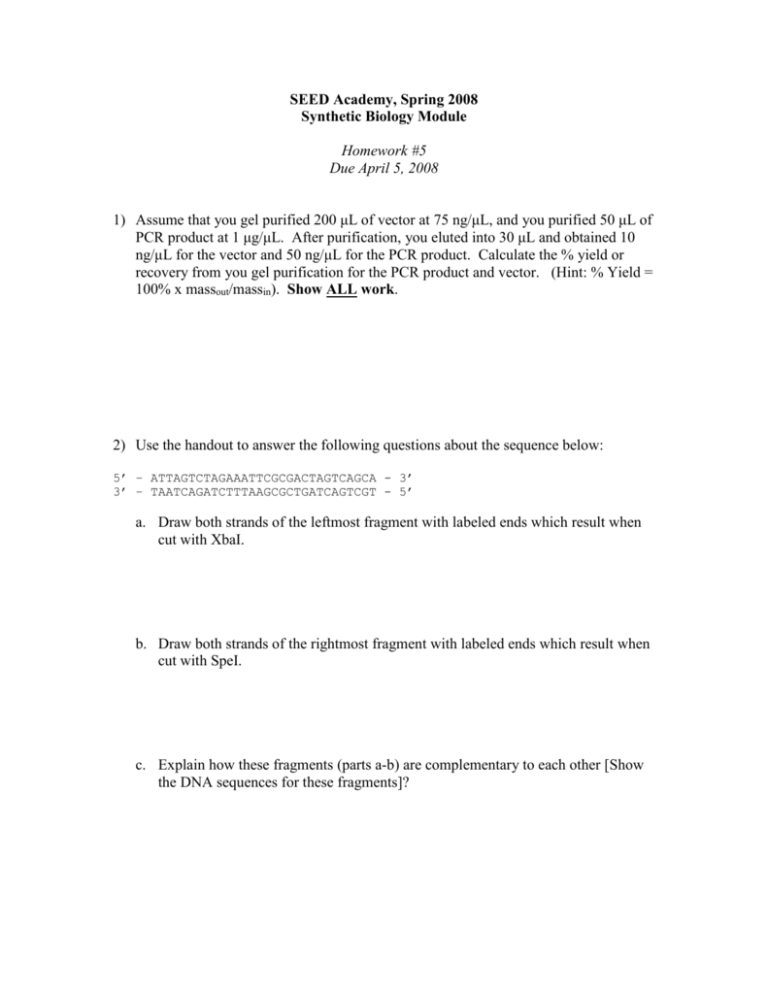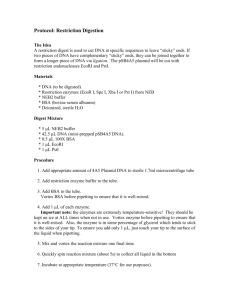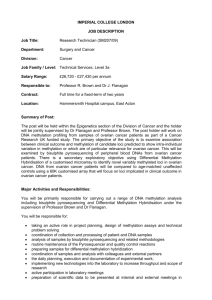1) - OpenWetWare
advertisement

SEED Academy, Spring 2008 Synthetic Biology Module Homework #5 Due April 5, 2008 1) Assume that you gel purified 200 μL of vector at 75 ng/μL, and you purified 50 μL of PCR product at 1 μg/μL. After purification, you eluted into 30 μL and obtained 10 ng/μL for the vector and 50 ng/μL for the PCR product. Calculate the % yield or recovery from you gel purification for the PCR product and vector. (Hint: % Yield = 100% x massout/massin). Show ALL work. 2) Use the handout to answer the following questions about the sequence below: 5’ – ATTAGTCTAGAAATTCGCGACTAGTCAGCA - 3’ 3’ – TAATCAGATCTTTAAGCGCTGATCAGTCGT - 5’ a. Draw both strands of the leftmost fragment with labeled ends which result when cut with XbaI. b. Draw both strands of the rightmost fragment with labeled ends which result when cut with SpeI. c. Explain how these fragments (parts a-b) are complementary to each other [Show the DNA sequences for these fragments]? d. Can this resulting fragment be cut by XbaI or SpeI? Why? 3) Read "Idempotent Vector Design for Standard Assembly of BioBricks" (http://hdl.handle.net/1721.1/21168 first 6 pages) and answer the following questions. a. What is the motivation for a standard assembly scheme? b. What does it mean for assembly to be idempotent? c. What are the 4 standard enzymes used in BioBricks assembly? d. What enzymes should be used to cut a BioBrick part that we wish to add to the back of another part? e. Indicate the recipe for a ligation of a plasmid and an insert. Your plasmid is 3000 bp and the insert is 1000 bp. Assume that all nucleotides are 1000 Da. Assume that you want 1 nM concentrations of each of the DNA components in your ligation. Plasmid (10 ng/μL) _____ μL Insert (50 ng/μL) _____ μL Ligation Buffer (10X) _____ μL T4 DNA Ligase (Enzyme) _0.5 _ μL Water _____ μL Total _10_ μL 4) Transformation Prep Question a. Use wikipedia to find the molecular biology definition of “Transformation.” Read the description and tell us what this process is in YOUR OWN WORDS. b. Describe two methods in which we can make cells competent for transformation and how the cells are treated during transformation. (Hint: also on wikipedia. If we are making them competent, they don’t have this ability natively.) c. Think back to quiz #1 on antibiotic resistance (I know it was a while ago). How do we utilize the concept of antibiotic resistance to “select” only the cells we want after transformation? (Hint: we only want cells that have the DNA we want to put into them) d. Look up the plasmid pSB4A5 that we are using from the parts registry (http://parts.mit.edu/registry/index.php/Part:pSB4A5). What antibiotic resistance does the plasmid pSB4A5 have? e. A replication origin is required for plasmids to replicate inside cells. What is the name of the origin in pSB4A5? f. Again, think back to the first day in lab and the first quiz. In biology, we have a hard time looking at just one cell to make sure it is what we want. What method should we use to make sure that all of the bacteria we pick are the same (or mono-clonal)? Project Development Question g. Select one topic for further work this semester; this will be the topic for your final project. Email the topic to seed-synbio@mit.edu to get approval from the instructors h. Using one or two of the parts you identified in the last assignment, describe how you would go about making these into BioBrick parts and cloning them into E. coli. Describe the basic cloning steps you would include if you were actually going to complete this project. What will you use as the source for the part? What plasmids and enzymes will you use? (Hint: Use what we have been doing in lab as a template for how you would do this!) 5) How much time did you spend on homework this week? PstI Nomenclature Update Recognition Site: Source: A E. coli strain that carries the PstI gene from Providencia stuartii 164 (ATCC 49762). Reagents Supplied: NEBuffer 3 (10X) BSA (100X) Enzyme Properties Activity in NEBuffers: NEBuffer 1: 75% NEBuffer 2: 75% NEBuffer 3: 100% NEBuffer 4: 50% When using a buffer other than the optimal (supplied) NEBuffer, it may be necessary to add more enzyme to achieve complete digestion. Methylation Sensitivity: dam methylation: Not sensitive dcm methylation: Not sensitive CpG methylation: Not sensitive Heat Inactivation: 80°C for 20 minutes Survival in a Reaction: Minimum units to digest 1 µg of substrate DNA in 16 hours: 0.50 unit(s) Reaction & Storage Conditions Reaction Conditions: 1X NEBuffer 3 Supplemented with 100 μg/ml Bovine Serum Albumin Incubate at 37°C. 1X NEBuffer 3: 50 mM Tris-HCl 100 mM NaCl 10 mM MgCl2 1 mM Dithiothreitol pH 7.9 @ 25°C Unit Definition: One unit is defined as the amount of enzyme required to digest 1 µg of λ DNA in 1 hour at 37°C in a total reaction volume of 50 µl. Concentration: 20,000 units/ml and 100,000 units/ml Unit Assay Substrate: λ DNA Storage Conditions: 10 mM Tris-HCl 200 mM NaCl 1 mM Dithiothreitol 0.1 mM EDTA 200 µg/ml BSA 50% Glycerol 0.15% Triton X-100 pH 7.4 @ 25°C Storage Temperature: -20°C Diluent Compatibility: Diluent C Notes General notes: 1. Number of units required to cleave 1 μg of supercoiled plasmid DNA in one hour: pUC19 = 1 unit, pBR322 = 1 unit, LITMUS = 1 unit. XbaI Nomenclature Update Recognition Site: Source: A E. coli strain that carries the XbaI gene from Xanthomonas badrii (ATCC 11672). Reagents Supplied: NEBuffer 2 BSA Enzyme Properties Activity in NEBuffers: NEBuffer 1: 0% NEBuffer 2: 100% NEBuffer 3: 75% NEBuffer 4: 75% When using a buffer other than the optimal (supplied) NEBuffer, it may be necessary to add more enzyme to achieve complete digestion. Methylation Sensitivity: dam methylation: Blocked by overlapping dcm methylation: Not sensitive CpG methylation: Not sensitive Heat Inactivation: 65°C for 20 minutes Survival in a Reaction: Minimum units to digest 1 µg of substrate DNA in 16 hours: 0.13 unit(s) Reaction & Storage Conditions Reaction Conditions: 1X NEBuffer 2 Supplemented with 100 μg/ml Bovine Serum Albumin Incubate at 37°C. 1X NEBuffer 2: 10 mM Tris-HCl 50 mM NaCl 10 mM MgCl2 1 mM Dithiothreitol pH 7.9 @ 25°C Unit Definition: One unit is defined as the amount of enzyme required to digest 1 µg of λ DNA (dam-/HindIII digest) in 1 hour at 37°C in a total reaction volume of 50 µl. Concentration: 20,000 units/ml and 100,000 units/ml Unit Assay Substrate: λ DNA (dam-/Hind III digest) Storage Conditions: 10 mM Tris-HCl 50 mM NaCl 1 mM Dithiothreitol 0.1 mM EDTA 200 µg/ml BSA 50% Glycerol pH 7.4 @ 25°C Storage Temperature: -20°C Diluent Compatibility: Diluent A SpeI Nomenclature Update Recognition Site: Source: A E. coli strain that carries the SpeI gene from Sphaerotilus species (ATCC 13923). Reagents Supplied: NEBuffer 2 BSA Enzyme Properties Activity in NEBuffers: NEBuffer 1: 75% NEBuffer 2: 100% NEBuffer 3: 25% NEBuffer 4: 75% When using a buffer other than the optimal (supplied) NEBuffer, it may be necessary to add more enzyme to achieve complete digestion. Methylation Sensitivity: dam methylation: Not sensitive dcm methylation: Not sensitive CpG methylation: Not sensitive Heat Inactivation: 65°C for 20 minutes Survival in a Reaction: Minimum units to digest 1 µg of substrate DNA in 16 hours: 0.50 unit(s) Reaction & Storage Conditions Reaction Conditions: 1X NEBuffer 2 Supplemented with 100 μg/ml Bovine Serum Albumin Incubate at 37°C. 1X NEBuffer 2: 10 mM Tris-HCl 50 mM NaCl 10 mM MgCl2 1 mM Dithiothreitol pH 7.9 @ 25°C Unit Definition: One unit is defined as the amount of enzyme required to digest 1 µg of Adenovirus-2 DNA in 1 hour at 37°C in a total reaction volume of 50 µl. Concentration: 10,000 units/ml and 50,000 units/ml Unit Assay Substrate: Adenovirus-2 DNA Storage Conditions: 10 mM Tris-HCl 50 mM KCl 1 mM Dithiothreitol 0.1 mM EDTA 200 µg/ml BSA 50% Glycerol pH 7.4 @ 25°C Storage Temperature: -20°C Diluent Compatibility: Diluent A Notes General notes: 1. Cleaves to leave a 5´ CTAG extension which can be efficiently ligated to DNA fragments generated by AvrII, NheI, or XbaI. EcoRI Nomenclature Update Recognition Site: Source: An E. coli strain that carries the cloned EcoRI gene from E. coli RY13 (R.N. Yoshimori). Reagents Supplied: NEBuffer EcoRI (10X) Enzyme Properties Activity in NEBuffers: NEBuffer 1: 100% NEBuffer 2: 100% NEBuffer 3: 100% NEBuffer 4: 100% When using a buffer other than the optimal (supplied) NEBuffer, it may be necessary to add more enzyme to achieve complete digestion. Methylation Sensitivity: dam methylation: Not sensitive dcm methylation: Not sensitive CpG methylation: Impaired by overlapping Heat Inactivation: 65°C for 20 minutes Survival in a Reaction: Minimum units to digest 1 µg of substrate DNA in 16 hours: 0.13 unit(s) Reaction & Storage Conditions Reaction Conditions: 1X NEBuffer EcoRI Incubate at 37°C. 1X NEBuffer EcoRI: 100 mM Tris-HCl 50 mM NaCl 10 mM MgCl2 0.025 % Triton X-100 pH 7.5 @ 25°C Unit Definition: One unit is defined as the amount of enzyme required to digest 1 µg of λ DNA in 1 hour at 37°C in a total reaction volume of 50 µl. Concentration: 20,000 units/ml and 100,000 units/ml Unit Assay Substrate: λ DNA Storage Conditions: 300 mM NaCl 10 mM 2-Mercaptoethanol 0.1 mM EDTA 200 µg/ml BSA 50% Glycerol 0.15% Triton X-100 pH 7.5 @ 25°C Storage Temperature: -20°C Diluent Compatibility: Diluent C Notes General notes: 1. Conditions of low ionic strength, high enzyme concentration, glycerol concentration > 5%, or pH > 8.0 may result in star activity.




